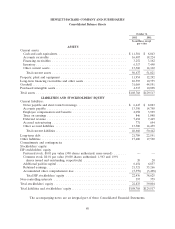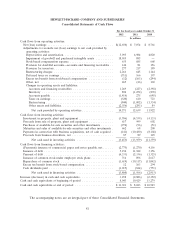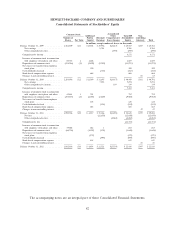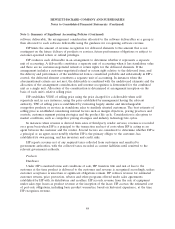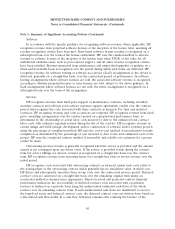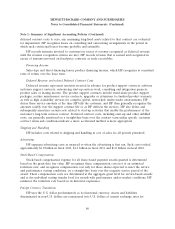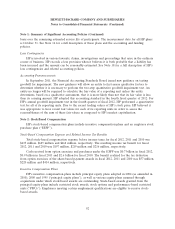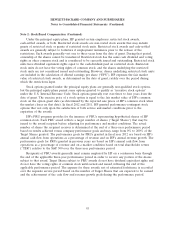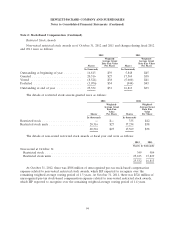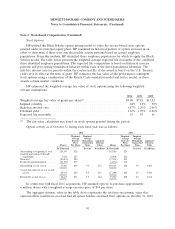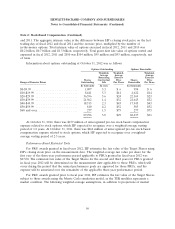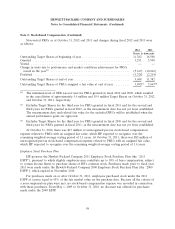HP 2012 Annual Report Download - page 96
Download and view the complete annual report
Please find page 96 of the 2012 HP annual report below. You can navigate through the pages in the report by either clicking on the pages listed below, or by using the keyword search tool below to find specific information within the annual report.HEWLETT-PACKARD COMPANY AND SUBSIDIARIES
Notes to Consolidated Financial Statements (Continued)
Note 1: Summary of Significant Accounting Policies (Continued)
HP maintains cash and cash equivalents, short- and long-term investments, derivatives and certain
other financial instruments with various financial institutions. These financial institutions are located in
many different geographical regions, and HP’s policy is designed to limit exposure with any one
institution. As part of its cash and risk management processes, HP performs periodic evaluations of the
relative credit standing of the financial institutions. HP has not sustained material credit losses from
instruments held at financial institutions. HP utilizes forward contracts and other derivative contracts to
protect against the effects of foreign currency fluctuations. Such contracts involve the risk of
non-performance by the counterparty, which could result in a material loss.
HP sells a significant portion of its products through third-party distributors and resellers and, as a
result, maintains individually significant receivable balances with these parties. If the financial condition
or operations of all of these distributors’ and resellers’ aggregated accounts deteriorate substantially,
HP’s operating results could be adversely affected. The ten largest distributor and reseller receivable
balances, which were concentrated primarily in North America and Europe, collectively represented
approximately 14% of gross accounts receivable at both October 31, 2012 and October 31, 2011. No
single customer accounts for more than 10% of accounts receivable. Credit risk with respect to other
accounts receivable and financing receivables is generally diversified due to the large number of entities
comprising HP’s customer base and their dispersion across many different industries and geographical
regions. HP performs ongoing credit evaluations of the financial condition of its third-party distributors,
resellers and other customers and requires collateral, such as letters of credit and bank guarantees, in
certain circumstances. The past due or delinquency status of a receivable is based on the contractual
payment terms of the receivable.
Other Concentration
HP obtains a significant number of components from single source suppliers due to technology,
availability, price, quality or other considerations. The loss of a single source supplier, the deterioration
of HP’s relationship with a single source supplier, or any unilateral modification to the contractual
terms under which HP is supplied components by a single source supplier could adversely affect HP’s
revenue and gross margins.
Allowance for Doubtful Accounts
HP establishes an allowance for doubtful accounts for trade and financing receivables. HP
maintains bad debt reserves based on a variety of factors, including the length of time receivables are
past due, trends in overall weighted-average risk rating of the total portfolio, macroeconomic
conditions, significant one-time events, historical experience and the use of third-party credit risk
models that generate quantitative measures of default probabilities based on market factors and the
financial condition of customers. HP records a specific reserve for individual accounts when HP
becomes aware of specific customer circumstances, such as in the case of bankruptcy filings or
deterioration in the customer’s operating results or financial position. If there are additional changes in
the circumstances related to the specific customer, HP further adjusts estimates of the recoverability of
receivables.
See Note 11 for a full description of the credit quality of financing receivables and the allowance
for credit losses.
88




